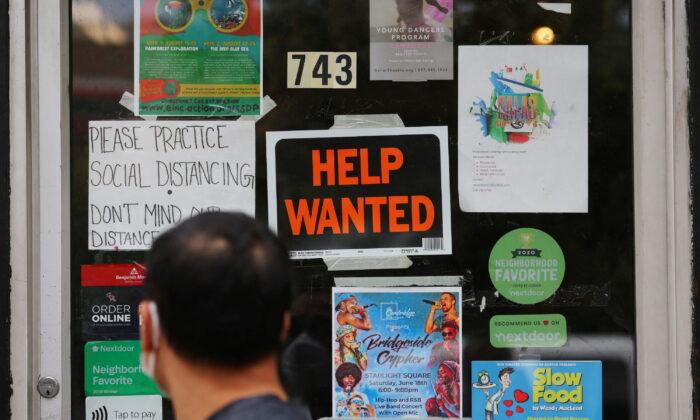The number of job openings in the United States—a measure of labor market tightness—came in far higher than analysts expected, fueling concerns that more inflation is on the way and that the Federal Reserve will have to double down on aggressive rate increases to quash price pressures.
“This remains an opportune time when workers can leverage the still broadly robust job market, with the number of job openings substantially outnumbering the number of available workers,” Bankrate senior economic analyst Mark Hamrick told The Epoch Times in an emailed statement.
At 10.5 million, the number of open jobs far exceeds the 6 million people that are unemployed in the United States. This means that there are roughly 1.75 available jobs per unemployed person.
While that’s better than the nearly 2-to-1 levels seen in July, when job vacancies soared to a record high, it’s still well above the roughly 1.2 jobs per unemployed person in the years before the pandemic.
It’s also higher than Fed officials are comfortable with, because such a mismatch between job vacancies and the number of unemployed makes businesses more likely to boost wages to attract workers, which tends to fuel inflation.
At last count, inflation was running at just more than 7 percent in November, not much lower than the recent June peak of 9 percent. That’s despite the fact that the Fed hiked rates by a cumulative 4.25 percentage points last year, the fastest pace since the 1980s.
Tackling Inflation Won’t Be ‘Painless’
The Fed chief has repeatedly expressed irritation with the historically elevated vacancies-to-unemployed ratio and has called for the need to bring the jobs market into greater balance to ease inflationary pressures.“The labor market is particularly strong, but it is clearly out of balance, with demand for workers substantially exceeding the supply of available workers,” Powell said in a speech in late August.
Powell reiterated in September the “need to have softer labor market conditions,” while acknowledging that pushing interest rates higher would likely mean higher rates of joblessness.
“We need to complete this task,” he said at the time, noting that it won’t be “painless.”
While that pain has yet to be felt in the form of a rise in unemployment, which remains at 3.7 percent, it has already filtered into the Fed’s economic forecasts, which call for a deeper economic slowdown.
“Over the course of the year, we have taken forceful actions to tighten the stance of monetary policy,” Powell said at the Dec. 14 press conference.
“We have covered a lot of ground, and the full effects of our rapid tightening so far are yet to be felt. Even so, we have more work to do.”
With rate hikes having a cooling effect on the economy—and a deeper freeze in store—Powell said Fed officials expect supply and demand conditions in the labor market to come into better balance over time and relieve some of the upward pressures on wages and prices.
The Fed expects the unemployment rate to rise to 4.6 percent by the end of 2023.
The JOLTS report included another sign of labor market tightness, which isn’t something the Fed wants to see.
The quits level rose by 126,000, sending the so-called quits rate up slightly to 2.7 percent, a reading that suggests workers are leaving their employers willingly, confident in their ability to find a better job.
At the same time, the report shows that hiring fell slightly, to 6.055 million from 6.111 million.
Markets are now awaiting the release of the minutes of the Fed’s December policy meeting, a document that will be released later on Jan. 4 and will be scoured closely for clues about Fed officials’ thinking about the economy and inflation, and hints about future rate moves.





